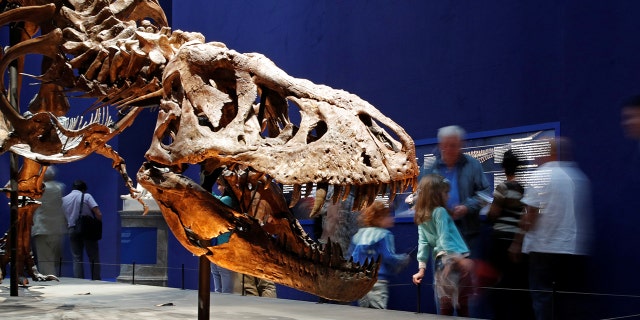T. Rex might actually be three separate species: study
NEW York can now listen to Fox News articles!
The iconic Tyrannosaurus rex, or “T. Rex,” might need to be re-categorized into three distinct species, according to researchers.
The Tyrannosaurus rex is the only recognized species of the group of dinosaurs Tyrannosaurus to date – though previous research has reportedly acknowledged variation across Tyrannosaurs skeletal remains.
In a controversial new study published Tuesday in the peer-reviewed journal Evolutionary Biology, South Carolina and Maryland paleontologists conducted an analysis of skeletal remains they said reveal physical differences in the femur and other bones and dental structures.
THE ROCK’S T-REX SKULL ON ‘MANNINGCAST’ RAISES QUESTIONS OVER WHETHER IT’S REAL HISTORIC FOSSIL
Based on a dataset of 37 specimens, the group looked at the robustness in the femur of 24 specimens and measured the diameter of the base of teeth or space in the gums to assess if specimens had one or two slender teeth resembling incisors.
According to an accompanying release, the scientists observed that the femur varied across specimens, with two times more robust femurs than svelte ones across specimens. Robust femurs were also found in some juvenile specimens and “gracile” femurs were found in some that were full adult size, suggesting that variation is not related to growth.
Dental structure also varied and those with one incisorform tooth were correlated with often having higher femur gracility.

Visitors look at a 67 million year-old skeleton of a Tyrannosaurus Rex dinosaur, named Trix, during the first day of the exhibition “A T-Rex in Paris” at the French National Museum of Natural History in Paris, France, June 6, 2018.
(REUTERS/Philippe Wojazer)
They explained the Tyrannosaurus specimens “exhibit such a remarkable degree of proportional variations, distributed at different stratigraphic levels, that the pattern favors multiple species at least partly separated by time; ontogenetic and sexual causes being less consistent with the data.”
“Variation in dentary incisiform counts correlate with skeletal robusticity and also appear to change over time,” the authors noted.
28 specimens could be identified in distinct layers of sediment at the Lancian upper Maastrichtian formations in North America – which was estimated to be from between 67.5 to 66 million years ago – and the paleontologists compared Tyrannosaurus specimens with other theropod species found in lower layers of sediment.
Only robust Tyrannosaurus femurs were found in the lower layer of sediment – and variation was not different to that of other theropod species – which the release said indicates that just one species of Tyrannosaurus likely existed at this point.
However, the variation in Tyrannosaurus femur robustness in the top layer of the sediments was higher, suggesting the specimens had physically developed into more distinct forms and other dinosaur species.
NEWLY-DISCOVERED DINOSAUR TERRORIZED THE TYRANNOSAURUS
“We found that the changes in Tyrannosaurus femurs are likely not related to the sex or age of the specimen,” lead author Gregory Paul said in a statement. “We propose that the changes in the femur may have evolved over time from a common ancestor who displayed more robust femurs to become more gracile in later species. The differences in femur robustness across layers of sediment may be considered distinct enough that the specimens could potentially be considered separate species.”
Based on that evidence, the researchers said three morphotypes – what Science Direct defines as any of a group of different types of individuals of the same species in a population – and two additional species of Tyrannosaurus were “diagnosed” and named.
“One robust species with two small incisors in each dentary appears to have been present initially, followed by two contemporaneous species (one robust and another gracile) both of which had one small incisor in each dentary, suggesting both anagenesis and cladogenesis occurred,” they continued.
Evolution can take place by anagenesis, in which changes occur within a lineage. Whereas, in cladogenesis, a lineage splits into two or more separate lines.
The authors nominated two potential species: “Tyrannosaurus imperator” and “Tyrannosaurus regina.”
Tyrannosaurus imperator relates to specimens found at the lower and middle layers of sediment, with more robust femurs and usually two incisor teeth.
Tyrannosaurus regina is linked to specimens from the upper and possibly middle layers of sediment, with slenderer femurs and one incisor tooth.
The Tyrannosaurus rex was identified in the upper and possibly middle layer of sediment, with more robust femurs and only one incisor tooth.
The authors acknowledged that they cannot rule out that variation is due to extreme individual differences, or atypical sexual dimorphism, rather than separate groups. They also cautioned that the location within sediment layers is not known for some specimens.
CLICK HERE TO GET THE FOX NEWS APP
Reaction to the study from scientists has been largely skeptical, with some claiming the paper does not have enough evidence to reach its conclusions – and raising concerns over some of the specimens included in the study to National Geographic.
Paul told The New York Times on Feb. 28 that he knows his proposal is provocative.
“I’m aware that there could be a lot of people who aren’t going to be happy about this,” he told the publication. “And, my response to them is: Publish a refutation.”
